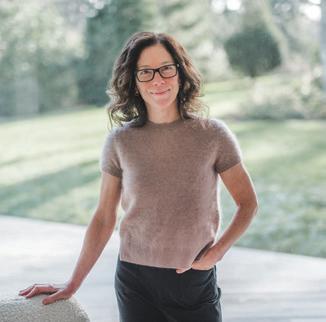Helping Hand Mirror Mirror
String Theory


Helping Hand Mirror Mirror
String Theory






“Beckey was absolutely fantastic to work with. From the start, she fully listened and understood what I was looking for and did not try to push other options. When a wonderful home came on the market in my parameters, she sent it to me almost instantly. The entire experience was seamless and easy.”


I’ve always loved work. (Our longtime house sitter says it’s because I’m a Capricorn. I have no idea what that means, but I’ll own it.) I currently have two “job” jobs as well as wrangling half of the house chores, and a fair share of tending to our pets, Kismet, Zuri and Fig with my husband Alan. And without sounding sappy or cloyingly precious, my most important job has been as a mother to our daughter Elle for the past 18 years. By every measure she’s been an “easy” kid, yet as nearly all parents know, it’s still extraordinarily hard, soul wrenching work…work that gives you sleepless nights, grey hair and TMJ.
But like we’ve prepared for, and as it’s supposed to, my “work” as a mother is about to change. Elle is off to college this fall at Santa Clara University, so my day to day is going to look a lot different. The time I’m about to get back from not picking up errant socks alone is immeasurable. From what I hear, being an empty nester is fantastic, and many of my friends make it look amazing, but I don’t know if I’m going to be any good at it.

I’m heartened to see that many of the people featured in the stories in this issue aren’t just making their next chapters look bearable, they’re thriving. They’re collecting art, making art, playing in orchestras, baking, volunteering and even sailing and flying around the globe. Intellectually, I know that they can’t have felt that differently than I do, and just look at them now. We’ll see what fills my blank space.
So, to my friends and neighbors also entering your renaissance, I’ll see you on the other side.

Allison Schuchman Editor in Chief
OWNER & EDITOR IN CHIEF
Allison Schuchman
D IRECTOR OF SALES & COMMUNITY RELATIONS
Stephanie Reese
CONTRIBUTING EDITORS
Connie Bye
George Soltes
CREATIVE DIRECTOR
Gisela Swift
PRODUCTION MANAGER
Mark Swift
WRITERS
Audrey Nelson, Christy Carley, Jeff Fraga, Kerrie Houston Reightley, Luciano Marano, Elle Schuchman, Bajda Welty, Anne Willhoit
PHOTOGRAPHERS
Annie Graebner, Dinah Satterwhite, Kelvin Hughes, Luciano Marano, Pete Saloutos
CONTACT
(206) 486-4097 • pnwbainbridge@gmail.com
Instagram @pnwbainbridge
Facebook at PNW Bainbridge
Letters From Stephanie Reese
When I first moved to the island, my husband would often tell me I was overdressed. Platform shoes and a frilly dress at 4 p.m. in Safeway? Maybe. But fashion, for me, has always been art—an extension of the life I’ve lived. As an artist who traveled the world, lived out of suitcases and sang under lights, settling into a quieter life was an adjustment I’ve grown to love. But some things, like my love of fashion and how I dress, I’ve kept. It’s who I am and a joyful reminder of my past, too.
Recently, I sang at the memorial of my dear friend Dura. She, too, had lived a vibrant, expansive life before arriving here. After she passed, I was given her pink feather boa.


She was not a flamboyant fashionista, and I never saw her wear or use it, but when I held the boa, I understood. To me, it was a reflection of the artist and fun, sunshiny person she was…and maybe a reflection of her life before the island, too.
Choosing a song for her memorial was difficult, but “Both Sides Now” came to me. Joni Mitchell’s words mirror what I’ve come to understand: that life and art hold contradictions—illusion and truth, glamour and grounding, soaring and settling.
Dura and I shared that knowing. We had lived both sides.
I sang wrapped in her boa, like a hug from the past. I felt her with me. We both knew what it meant to live loudly, then softly. To be seen, then still. It was an honor to sing for my friend in her boa. I will surely wear it again, for Dura and for me.
{weissinger}







Editor’s Letter 4
High Notes 5
Contributors 9
Epilogue 9
Calendar 62 departments
Shake Town 11
Local author’s book selected for BI Reads
Medaling in Service 12
Girl Scout revives area pocket park
Bainbridge Prepares 16
Help is All About Local
Grace Note 18
Author explores trauma, emotion and the music within
Stringing Together 23
Quartet shares a passion for music
Adieu to Summer 24
Settle in and let fall help you prepare for winter
Meow 34
PAWS celebrates a half-century
By Sky and Water 38
Islander sails and flies solo to all continents
Pride and Joy 42
Elders are a vital and friendly resource
Mirror Image 44
Photographers create abstract art from reflections




A Taste of Fall 48
Pumpkin Coffee Cake AND ANOTHER THING
Now & Then 14
Magic Moments 56 In Focus 64


Tacos Walt’s Market
Island photographer Pete Saloutos said after having waited years to photograph this magnificent Japanese Maple, he was awe stuck by its beauty. We agree. Fall foliage has a way of doing that. Tag us on Instagram at @pnwbainbridge with your autumnal snaps to share the season’s splendor.
We recently checked in with Rob Freese, owner of Bainbridge Pinball, who was profiled in the spring issue (Full Tilt, page 30). Freese is happy to report that pinball fever continues to spread across the island and beyond. Since the story came out, the company’s stable of pinball machines has increased to 16 and it recently began operating games at the Sip, a new self-serve taproom and eatery in downtown Poulsbo. Freese invites anyone interested in catching the pinball bug to come to the weekly Wednesday evening tournament at the Bainbridge Brewing Taproom.
Social media lead and Rotary member Jessica Perkins gave us an inspiring recap on this year’s auction after our story in the summer issue (Follow the Money, page 28) examined where and how the funds it raises are distributed into the community. She said that in its 65th year, the nonprofit registered 1,077 new volunteers (including 734 kids), part of the 2,500 helpers who lent a hand, racking up 3,353 combined hours of service and together eating 81 dozen doughnuts. Most volunteers came from Washington State, but some traveled from New York, Florida, Texas, Guatemala and even Denmark to take part. When all was said and done, a whopping $1,018,718.75 was raised in just six hours of sales!

Luciano Marano, an award-winning writer and photographer, is the author of a trilogy of werewolf novellas, The Ambush Moon Cycle, as well as numerous works of short fiction, which have appeared in anthologies, magazines and podcasts. A former editorial staff member at both the Bainbridge Island Review and Port Townsend & Jefferson County Leader, his written and photographic reporting has earned a number of industry accolades, including being twice named a Feature Writer of the Year by the Washington Newspaper Publishers Association. A U.S. Navy veteran, originally from rural western Pennsylvania, he now resides on Bainbridge Island.
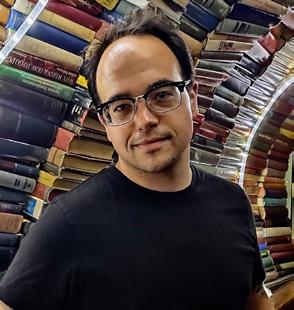
Dinah Satterwhite has enjoyed living on Bainbridge for 28 years, working in high tech and marketing management before that. Dinah enjoys living on the water and gardening with a view and is constantly inspired by the Pacific Northwest. As a piano teacher since she was 16, she is now composing pop, country, and inspirational solos. Her photography includes both commercial and fine art, and she participates in regional art shows like the BI Studio Tour which she manages. Tennis has always been a big part of her life, and she currently plays on local leagues. Other loves include family, writing screenplays, cooking, and dogs!

Christy Carley grew up on Bainbridge Island and now divides her time between the Pacific Northwest and the northwest corner of Spain where she teaches English. She graduated from Whitman College with a degree in history and, in addition to teaching, has worked as a writer and fact-checker for a handful of publications in the U.S. When she’s not working, she’s probably reading, taking photos or (slowly) teaching herself French and Galician.
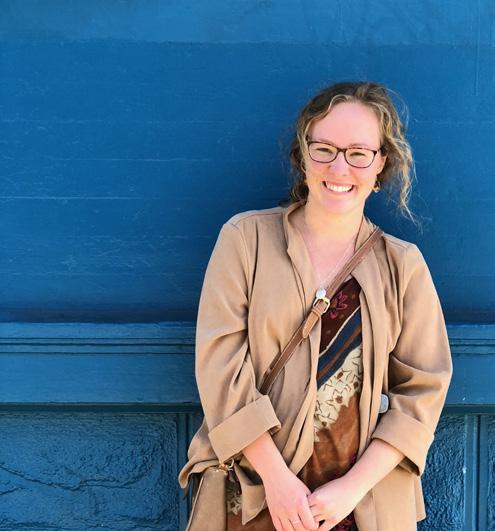








Unquestionably, Bainbridge Island is a paradise for both authors and readers.
The City of Bainbridge Island launched the B.I. Reads program in 2022, aiming to build community through the reading of one book together, encourage creative expression and foster beneficial dialogue.

KERRIE HOUSTON
Through a community voting process, this year’s selection is “This is Chance!: The Great Alaska Earthquake, Genie Chance, and the Shattered City She Held Together,” by islander Jon Mooallem. He is the author of two other critically acclaimed nonfiction books. He currently writes (fascinating) obituaries and features for
The Wall Street Journal and, for nearly 20 years, wrote for The New York Times magazine.
Events highlighting the themes of “This is Chance” will continue through October 2025, including a LeadHERship Spotlight, to honor local women leaders, and a craft talk on writing nonfiction by Mooallem.
Mooallem said he was surprised by how little was known about the largest recorded earthquake in American history. The quake occurred in Anchorage, Alaska in the spring of 1964, registering 9.2 on the Richter Scale and lasting approximately 4.5 minutes with 52 separate aftershocks.

He tells the story of Genie Chance, a working mother and part-time radio reporter, who broadcast tirelessly in the aftermath of the disaster, helping to pull the devestated community back together. “I found out that Chance’s daughter had all these boxes and recordings and material,” Mooallem said. “I simultaneously felt obligated to tell the story and more excited than ever. Having all that untouched archival stuff to work with is a writer’s dream.“
Mooallem faced his own disaster, launching the critically acclaimed book in the midst of the COVID pandemic. “There was a big book tour scheduled and much higher hopes for real commercial success than with my previous books.”
But all is not lost. As a community, let’s give “This is Chance!” another chance, and discover Mooallem’s opus for ourselves.
For more information visit cityofbainbridgeisland.civilspace.io
Angeline Hamilton, a violinist and Bainbridge High School
BY KERRIE HOUSTON REIGHTLEY
cross country runner, has been reaching for the gold since childhood. But not just in music and sports. Soon, this Girl Scout of 13 years will cross the finish line for Girl Scouting’s most prestigious achievement, the Gold Award, for refurbishing T’Chookwap Park, overlooking the south shore of Port Madison.
Tucked into a storybook tunnel of trees and stately homes, T’Chookwap Park is a .32acre parcel of land owned by the Bainbridge Island Metropolitan Park & Recreation District.
Hamilton’s criteria for receiving the Gold Award included finding and researching an issue she cared about, identifying experts to help, and making and leading a team to carry out the plan. “You must [also] do 100 hours of solo work,” said Hamilton, 18. “It must be sustainable. You can’t do a onetime blood drive and call it good.”



Hamilton’s inspiration came from working with BIMPRD’s Student Conservation Corps, where she was paid to remove invasive species, and training with the cross country team.
“My team runs everywhere, and we often end by jumping off the Hidden Cove dock,” she said. “One time, we came upon this tiny grass area and park sign, and I said, ‘That’s the tiniest park I’ve ever seen.’ I realized it was covered in invasive species. Laurels, ivy and holly were everywhere.”
Hamilton started work on the park in fall of 2024 and aims to complete the project by fall of 2025. In the meantime, she’ll fundraise and collaborate with local nurseries and the Bainbridge Island Parks and Trails Foundation to buy plants and recruit manpower.
“There are opportunities to care for our parks,” Hamilton said, “such as being a park steward, where you can pull ivy, blackberries and Scotch broom. It’s everywhere. Frankly, if we’re not careful, it will take over.”


Ambrose Grow might not like what’s been done to his house.
The Civil War veteran and Kansas farmer arrived on the island in 1881, homesteading 160 acres along the Bainbridge waterfront and building his home on what’s now Parfitt Way.
BY GEORGE SOLTES

When not farming or founding churches (he and wife Amanda were charter members of the Eagle Harbor Congregational Church), Grow most enjoyed writing letters to local and East Coast newspapers lambasting the vices of dancing, card games and liquor. His 1909 obituary described him as “fearless in his onslaught of what he believed to be the great evil of our times.”
If he were alive today, the prolific writer and famous teetotaler would likely be firing off a letter to the editor

regarding the current occupant of the Grow family homestead, Bainbridge’s beloved watering hole, the Harbour Public House.



Custom Jeweler
Lapidary Artist
Jewelry Design

Engagement Rings - Alfie Norville Museum in Tucson Arizona Women in Excellence
Robin Callahan LLC, Contributor: Color Source Gems (Sapphire suppliers) - Platinum bridal set featuring a 4.55 ct. vivid blue pear-shape Sapphire accented by Diamonds (1.75 ctw.)
Robin this is SPECTACULAR!!!! You deserve every adulation out there!
Beautiful and different. I love the colorful design. It is fun. My favorite...it is so joyful A unique and beautiful ring!
Let a multi Award Winning Designer and Jeweler create your one of a kind heirloom
facebook.com/robincallahandesigns | instagram: @robincallahandesigns | appointments: robincallahan59@gmail.com Order Online at www.robincallahandesigns.com Specializing in

Scott James is obsessed with something most people would rather steer clear of: The worst-case scenario.
BY AUDREY NELSON
PHOTOS COURTESY BAINBRIDGE PREPARES
James is the founder of Bainbridge Prepares, a 501(c)(3) nonprofit that works to ready the island for various emergencies. Over the years, James has considered it all: fires, floods, earthquakes and more.
An interest in permaculture farming and sustainability led James—a social entrepreneur—down a roundabout path into emergency preparedness. He realized that the disaster response community tended to emphasize either individual or federal preparedness. That excluded a major middleman: neighborhoods.
“Post-natural disaster, life gets local very quickly,” James said. “If it’s a major bio-regional disaster—like the earthquake that’s going to hit Seattle sooner or later—then you are really relying on those neighbors not just for days, but for weeks to months and beyond.”
In 2011, James founded Bainbridge Prepares, intending to fill that neighborhood-sized gap. Since its founding, the organization has partnered with the city of Bainbridge, accumulated more than 750 volunteers and earned recognition from the International Association of Emergency Managers (IAEM) and the Federal Emergency Management Agency (FEMA).
In recent years, Bainbridge Prepares has gained a new advocate. Island resident Bob Johansen—a futurist and distinguished fellow

with the nonprofit Institute for the Future—serves as the organization’s informal foresight advisor. Shortly after moving to Bainbridge in 2020, Johansen met James through the community initiative, Imagine Bainbridge 2035.
James laughed as he recalled taking rambling, conversation-filled walks with Johansen. “It’s a good thing we live in a small town,” he said. “Otherwise, we would have been lost and our wives would have had to come track us down.”
One of the models that Johansen offered James on those walks was the BANI (pronounced “bonnie”) future.
The term BANI—Brittle, Anxious, Nonlinear and Incomprehensible—was coined by futurist Jamais Cascio, who co-authored Johansen’s forthcoming book.
Artificial intelligence, sudden global power shifts and vulnerabilities in systems, such as healthcare, have paved the way to a BANI future characterized by unpredictable change. At some level, Johansen explained, such a future “just doesn’t make sense.”
Still, that doesn’t mean we should stop preparing for what might be coming. In his book,

“Navigating the Age of Chaos,” Johansen lays out a “BANI Positive” leadership model. Upending BANI’s four tenets, “BANI+” urges people to be “Bendable, Attentive, Neuroflexible and Interconnected” when responding to uncertainty.
“We can’t understand what’s going on, but we’ve got to act anyway,” is how Johansen summarized the model.
By the time James and Johansen met, Bainbridge Prepares was already unknowingly modeling parts of the BANI+ framework. During the COVID pandemic, “if we were really brittle and rigid in thinking, ‘No, we can only use our volunteer corps just for earthquake
response and nothing else,’…we would have lost the opportunity to be of service to all of Kitsap County,” James said. Instead, volunteers’ “bendability” allowed Bainbridge Prepares to host vaccine clinics and fill supply shortages.
Pre-Johansen, Bainbridge Prepares also practiced both neuroflexibility—the ability to improvise—and interconnectedness. Volunteers often conducted tabletop exercises, running through emergency situations and potential responses. (Bainbridge Prepares still conducts these exercises, sometimes bringing them off the tabletop and into live simulations.) Meanwhile, through
connecting volunteers from diverse organizations, Bainbridge Prepares recently passed United Way to become Kitsap’s largest service organization.
Johansen’s guidance provided a vocabulary for what Bainbridge Prepares was already doing. It also gave rise to new collaborations. Bainbridge Prepares, the city and the fire department work closely together, but have long had separate strategic five-year plans. Johansen’s emphasis on interconnectedness helped coordinate those plans.
“Much of that has been inspired by conversations with Bob,” James said. “That’s exciting.”
These days, Johansen is consulting on James’ new venture, a nonprofit called Prepare Your Community that would bring Bainbridge Prepares’ organizational model to towns across the country.
Collectively and separately, Johansen and James have imagined and worked toward a more prepared Bainbridge. But both men emphasize that preparedness is more than just war games and forecasting. In Johansen’s words, it’s about “flipping the negative to positive.”
“If we approach building community resilience through love, we end up creating a town that’s more enjoyable to live in,” James added. “Even if the earthquake doesn’t happen.”


Rayne Lacko has always loved stories. As a little girl, tearing through book after book, she would have been delighted by this one: Once upon a time, a little girl who loved stories grew up to become an author.
Today, Lacko has two novels under her belt, as well as two social-emotional journals for kids and teens. Her most recent book, “The Secret Song of Shelby Rey,” was published in June, as a collaboration between SparkPress and Simon & Schuster.
“Shelby Rey” tells the story of 18-year-old Shelby, a traumatized teen drawn into the orbit of a rock ‘n’ roll band in 2008 Los Angeles. Whenever Shelby touches someone else, she can hear music—that person’s innermost self, uniquely expressed.
Just as with books, Lacko has always been drawn to music. “Everything has been sung about,” she marveled. “Everything has been expressed.” She recalled a moment in high school when a song blared through the cafeteria, raising the hair on her arms. Years later, that memory became the spark for “Shelby Rey.”
By 2009, Lacko was living in Orange County, tapping out “one paragraph at a time” of “Shelby Rey” while juggling a toddler and a kindergartener. An early draft of the novel found its way to local music therapists working with nonverbal teenage patients. Those therapists asked Lacko to design workbooks to accompany it.
Lacko was taken aback. “I thought I was writing something that was a lot more gritty,” she laughed.
But “Shelby Rey” had an undeniable emotional core.
“Sometimes when there’s difficulties or trauma in your life, it becomes impossible to talk about it or impossible to put words to it,” Lacko said. “We just pull back. We withdraw. As humans, though, we are meant to connect with each other.”
Once Lacko recognized the transformative arc that ran through “Shelby Rey,” she began her own transformation. She went back to school for a master’s degree in social-emotional learning, then for another in creative writing. After relocating to Bainbridge, she began teaching courses—including teen writing workshops at Bainbridge Public Library.
To Lacko, social-emotional learning is simply “how you’re able to regulate your own emotions and recognize them in other people.” That definition was on her mind when, a year and a half ago, her publisher asked her to return to the long-abandoned “Shelby Rey” manuscript. As Lacko revamped the book, she focused on infusing every sentence with social-emotional principles. The final draft represents the journey toward a more socially and emotionally aware self.
“She ends up having really intimate contact with other people and understands that they have a rich inner world,”
Lacko said. “And she longs for someone to be able to have that knowledge about her, too.”
The June publication of “Shelby Rey” marked the end of a nearly 20-year journey. But, Lacko acknowledged, her relief doesn’t mean she’s not anxious to have the final product out in the world. As an artist, “no matter what you do, you’re going to have to be vulnerable,” she said. “You’re going to have to say, ‘OK, I made this and you may look [at it].’”
At least there’s this: The people looking at Lacko’s work are overwhelmingly supportive.
In June, Bainbridge Public Library collaborated with Eagle Harbor Books to host a “Shelby Rey” book launch. An excited Lacko brought themed cookies and other giveaways for fans.

The launch reminded Lacko how much she values Bainbridge’s creative scene. Living in LA, she felt like “the lonely writer on the mountainside,” even among millions of other people. In contrast, “the community here is so incredibly rich and broad,” she said. “It’s so warm and so connected and so powerful.”
With “The Secret Song of Shelby Rey” in the rearview mirror, Lacko— who has worked across a range of genres—now plans to try her hand at writing fantasy. She’s unintimidated by the prospect.
“There’s no writer’s block,” she said. “I have a thousand ideas of potential things I could write about. You don’t wait for inspiration; you just sit down and begin. Inspiration will come once your hands are moving, once you’re under way.”

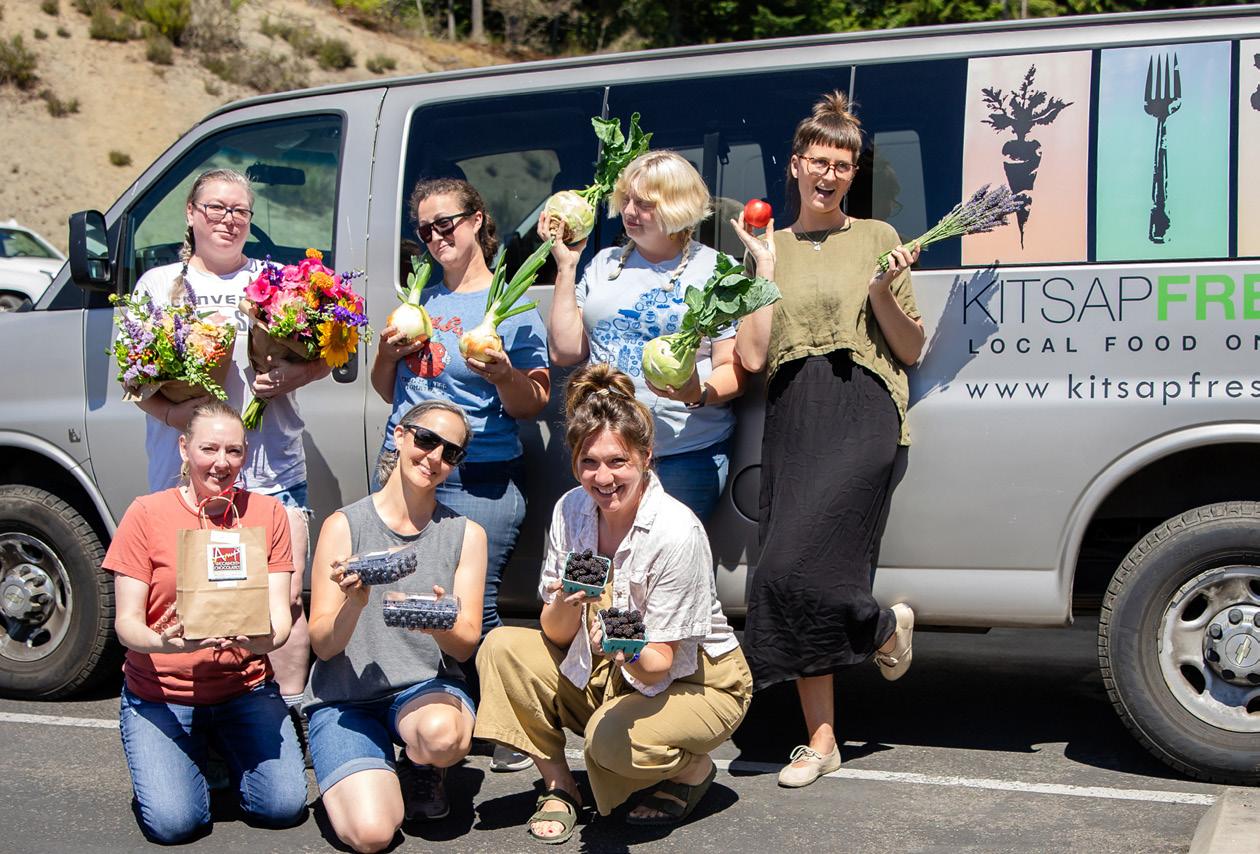
CSA, or Community Supported Agriculture, has long been a popular way for consumers to acquire fresh meat and produce straight from the source—all while supporting local growers.
The CSA model works like this: Consumers purchase “shares” from farmers looking to sell produce, meat, seafood and other goods. These shares function as memberships, allowing consumers to receive weekly boxes of the farm’s fresh items during the harvest season.
CSAs have plenty of upsides. They encourage face-toface interaction between farmers and consumers. They also offer producers a way to spread out the risks inherent in farming.
But on the consumer end, there can be friction points. Thanks to upfront membership payments, CSA boxes come like clockwork. “If you’re going on vacation—here on Bainbridge, which happens a lot during the summer—you miss those weeks,” said Brian MacWhorter, the longtime owner of Bainbridge’s Butler Green Farms. “Unless you have a neighbor pick them up for you, you just lose out.”
Another negative?
“Maybe you don’t get to choose what goes in [the box],” Renee Ziemann of Full Tilth Farms, said diplomatically.
MacWhorter was more direct: “Early on—in the early spring—you get a lot of turnips.”
Ziemann and MacWhorter are two of the Kitsap farmers who have decided to diversify their direct-to-consumer offerings beyond a single, traditional CSA program.
Ziemann still runs a small CSA for Full Tilth Farms, which is based in Poulsbo. But she’s also co-president of Kitsap Fresh, a nonprofit “online farmers market” with a flexible membership model.
Kitsap Fresh was founded in 2015 by a small group of farmers new to the area. Many of them had experience with the online farmers market model. “When they got to Poulsbo and saw that there wasn’t this alternative market, then they put a lot of their own time and energy into creating it,” Ziemann said. (Kitsap Fresh’s website proudly states that each farmer wrote a $35 check to get their new organization off the ground.)
Under the Kitsap Fresh model, local growers apply for membership on the site. Each week, approved growers post listings—with photos!—for any goods they have to sell. Over the weekend, consumers browse the postings and select what they
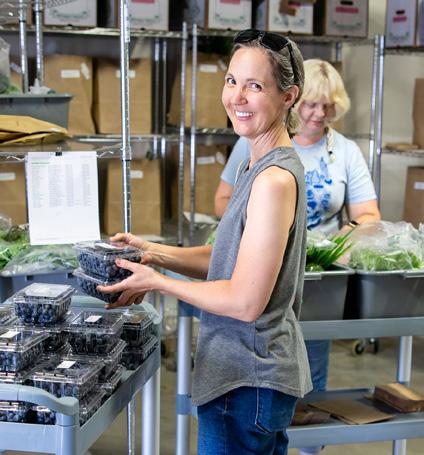

want. Growers then ship their bounty to Kitsap Fresh’s warehouse, where orders are sorted for pickup and delivery on Wednesday and Thursday.
Since its debut, Kitsap Fresh has ballooned into a county powerhouse. It now has eight distribution centers, including one at Bainbridge’s Johnson Farm. There is also a home delivery option. Last year, Kitsap Fresh paid more than $400,000 to local growers, according to its website.
Mary McKeirnan is Kitsap Fresh’s warehouse and operations manager. She grew up in an area without readily available fresh produce, and for her, Kitsap Fresh’s success reflects the Northwest’s passion for local food.
“If you’ve ever lived somewhere where they don’t have farmers markets and things like that, it’s amazing to have [Kitsap’s] community and celebration around food,” McKeirnan said. “We’re really lucky that Kitsap supports that.”
Many Kitsap residents turned to Kitsap Fresh during the COVID pandemic, spurred by shuttered farmers markets and disrupted supply chains. At the time, Kitsap Fresh was still a relatively small organization. Its growth throughout the pandemic “showed how necessary it is to have different models where people can access local food,” Ziemann said. “Kitsap Fresh filled a niche that didn’t exist for people.”
Even post-pandemic, Kitsap Fresh has continued to prove itself uniquely suited to the county’s needs.
Kitsap has “a lot of smaller farms,” Ziemann said. “We’re just zoned differently [than many neighboring counties]. And if
you’re a certain size farm, a farmers market and CSA are unattainable for you.”
For these smaller farms, Kitsap Fresh provides legitimacy along with profit. “When you post your food on Kitsap Fresh, you don’t look like a small table, like you do at the farmers market,” Ziemann explained. “You look like a farm, next to the other farms.”
‘Without Farms, There’s No Food’ Ziemann’s farming mentor, Brian MacWhorter, first established his Butler Green CSA program more than 30 years ago. But he caught the bug for farming long before that, “hanging out in the garden a lot, eating fresh stuff” as a kid. By the time he moved to Bainbridge—after an early career that included military service and establishing a farmers market in Eugene, Oregon—he was ready to create something tangible and community-oriented. He wanted to get good, local food into islanders’ hands.
MacWhorter helped found the Bainbridge Island Farmers’ Market and currently serves as its president. His farm has a weekly presence there. But his pet project—and a significant source of income for Butler Green—is his modified CSA.
Instead of providing pre-packaged boxes for pickup, MacWhorter sells produce out of a small Lovgreen Road farmstand, the walls of which are lined with bins of fresh tomatoes and greens. MacWhorter also sometimes sells products grown by other farms, such as raspberries and marionberries. While customers do pay an upfront fee for a
share, MacWhorter’s account model is more flexible than a traditional CSA, allowing people to skip pickup weeks, choose what produce they want and add money to their account at any time.

CSA members—as well as those interested in becoming members—can swing by the Lovgreen stand from noon to 5 p.m. every Tuesday and Thursday to investigate MacWhorter’s array of products.
And it’s an impressive array. MacWhorter has a superpower: He’s an expert in season extension, or growing crops outside of their natural growing and harvesting seasons. Customers often marvel: “You mean you have tomatoes in May?” Yes, MacWhorter said. “I can offer a bigger selection of stuff [than a traditional CSA],” he boasted. “People are excited about that.”
MacWhorter has operated his CSA stand for 35 years. Some customers, he said, have been coming to the stand all 35 of those years. Although these days MacWhorter is taking a less hands-on role at the stand, he still keeps his customers engaged with regular email newsletters. The communication feeds MacWhorter’s need for community; it also allows him to educate local
people on what it is, exactly, that farmers do. To him, there’s nothing more important than this advocacy.
“Without farms, there’s no food,” he said. “And if you don’t have farmers, you don’t have farms.”
Although proceeds from MacWhorter’s CSA stand don’t directly benefit his farming education nonprofit, Butler Green Farm School, he sees the stand as interconnected with his farming education work. Butler Green interns often work on projects for the stand (this year, it’s homemade kombucha and kimchi). And MacWhorter hopes that eventually, the farm school will buy out his farm and become his main legacy.
“When you think about what you’ve done in your lifetime, what mark you leave, how many people you helped—that’s what it’s about,” he said.
Still, it’s clear that despite his fascination with season extension, MacWhorter has no interest in extending his own season.
“They ask, ‘What happens when you die?’” he said, adding matter-of-factly, “The people that love you miss you. That’s the whole deal.”

The story of Tom Monk’s passion for the violin began on an elementary school playground in the Golden State—but not with dulcet tones wafting through the California breeze.

BY CHRISTY CARLEY
“I was in my third elementary school in third grade, and I was really unhappy,” Monk said, explaining that he was struggling at his new school after yet another move. He was getting into fights on the playground and, on one fateful day, remembers getting beaten up by a fourth grade girl.
“The principal came and grabbed me by the ear and pulled me into his office,” Monk recalled. Figuring he was just bored, the school head made Monk an offer. California had funding for every kid to learn an instrument or to sing in a choir and there was an extra violin sitting unused in the closet. The principal asked if Monk would like to try it.
Monk has played the violin ever since. Now retired after a long career as a pediatrician on the island, he is a member of the Bainbridge Island String Quartet.
The Quartet began as an offshoot of the Bainbridge Symphony Orchestra. Members have come and gone through the years, but violist Kathy Connelly has been there since the beginning. An avid knitter and the first employee of Churchmouse Yarns, Connelly was introduced to music at a young age. Through a robust strings program at the public schools in Aberdeen, Washington, Connelly learned to play violin and viola.
Marian Silberstein, who joined the group around the time of the COVID pandemic, is a retired engineer-turned-patent agent and plays violin along with Monk. Faun Tiedge, the quartet’s cellist, moved to the island a little over two years ago after a career as a professor, most recently at Linfield College, where she chaired the music department.
The Quartet plays sets covering a range of styles— recently incorporating some Latin tunes—and has performed in a variety of settings, including weddings, holiday parties, assisted living facilities and at The Marketplace in Lynwood Center. While all four musicians also play in the Bainbridge Symphony Orchestra, the Quartet allows them a little extra creative liberty and individual expression.
While the make-up of the quartet—a pediatrician, a knitter, an engineer and a professor—may sound like the beginning of a bar joke, Tiedge said that it is the mélange of backgrounds that brings life to the ensemble.
“As a musician I’ve always found that some of the most outstanding players have engaged in careers outside of music,” she said. “When they get together, the energy for making music is fantastic.”

Fall season is all about the harvest! Feeling satiated by abundance and preparing for another winter to settle in. Time to ignite your inner fire.
STORY AND PHOTOS BY BAJDA WELTY
Fall colors are red, orange, yellow and burgundy as seen among the blushing trees, falling leaves, ripe squash, berries and spawning salmon. Fall is brown, like the dying, dry foliage that reminds us that another year will soon end. It’s time to wind ourselves down in preparation to rest. The tomatoes are sauced, the berries are jammed, garlic and herbs are dried, potatoes are dug, beans are canned, cucumbers are pickled and honey is spun. This preparation for the season change is an important celebration of fall and insurance that we stay healthy during winter.
Imagine and celebrate the warmth and long productive days that the summer season delivered. Remember summer with pictures, cut flowers, herb-infused oils and bath salts to usher in the next season. Physically start to introduce warmth inside the body by eating foods we saved from summer, ingesting herbs we dried, brewing teas, making soups and roasting squash, potatoes and meats. This will support immune function for additional protection during cold and flu season and sustain high energy levels all winter.

If fall were a time of day, it might be afternoon. Hopefully, most of the hard work is done, and energy is bright but waning. The light is coming sideways into our eyes instead of from overhead and our brains and bodies feel fatigued. So, gather and finish your work, knowing that dinner and rest is fast approaching. Fall is the time of the moon cycle after the full moon. The peak has passed and completion is closer than at the beginning of the cycle. Fall is like the time of our lives when middle age has come and gone. Wisdom, self-awareness, confidence and perspective is the harvest. Gratitude and sharing the abundance of the harvest is the work at hand. We will mark fall with the Harvest Moon, Hunters Moon, Frost Moon and Cold Moon. Winter will blanket our island. The practice of change will carry us forward: change of season, change of body, change of thoughts and change of ideas.
Place desired herbs in a glass jar. Fill ¾ of the jar with herbs. Examples are sage, lavender, thyme, basil, lemon balm, nettle, calendula, borage, comfrey, rose, mint, raspberry leaves, rosemary and bay. Fill jar with oil (olive, coconut, grapeseed or avocado), so it covers the herbs. Place lid on tightly. Let soak for two to three weeks. Strain out herb material and store in a dark place. Use in cooking, baths or directly on the skin.
To make bath salt, add infused oil to coarse sea salt and scoop into bath water.
To make herbal table salt, grind dried herbs and add to salt or softened butter. This can be added to meals or used in cooking.





BY ALLI SCHUCHMAN // PHOTOS BY KELVIN HUGHES
Anne Reusché, a philanthropic communications consultant, said she first “discovered” Bainbridge in 2015 while working for Bloedel Reserve on an early campaign. »
Over the next five years, she and husband David Marzahl, an executive coach, returned frequently, in every season, to be certain that the island resonated as deeply as it had initially, when Reusché had returned home to Evanston, Illinois, declaring, “I know where we’re gonna live.”
With due diligence under their belts, in 2020, at the height of the COVID pandemic, the couple moved to Bainbridge, leaving behind their adult kids, son Kiel and daughter Lily, as well as Lily’s daughter, Gabby, who’s now 8 years old and who spends every summer on the island with her grandparents.
Reusché and Marzahl bought a home off Sunrise Drive, and although it’s lovely by every measure, it’s what’s inside—in every conceivable space and on every wall—that makes the home exceptional.
Take for instance the downstairs powder room. Nine pairs of footwear hang in two neat vertical rows. Among them: a geisha’s geta, Tribal slippers and a horseman’s spurs; shoes from Turkey, Vietnam, China, England and Spain. They share a form, yet each carries its own story—of the maker, the wearer and the journey that brought them to a small island in the Pacific Northwest.
Much like the shoes, Reusché and Marzahl’s home is a story about integrity and convergence: of past and present, of distinct origins woven into a cohesive whole. The imagined permutations of more than a thousand works of art within a single meaningful collection is nearly inconceivable, yet despite the incalculable odds, they’ve landed in perfect harmony.
Reusché said the inspiration for their collection—and its collecting— was in part motivated by the challenge of selling, donating and transporting their belongings during the pandemic. Armed with a keener relationship to possessions, the couple committed to a more intentional approach, resolving to source everything possible locally for their new home.


They came impressively close.
“From the mattresses to the artwork to the furniture,” Reusché said, “probably 80 percent came from Bainbridge; the rest from Seattle, with a few cherished family heirlooms mixed in.”
What began as a practical constraint evolved into something far more fulfilling—a treasure hunt that became deeply personal. Reusché said it helped forge a lasting connection to the land, the artisans and the community that the couple now calls home.
Furnishing the home—or the canvas as Reusché refers to it—was neither quick nor easy. “It was a labor of love with a focus on labor.” But as Reusché tiptoed into the challenge, visiting local antiques stores, resale shops and estate sales, one connection led to another, and her network began to grow.



“The people that I got to know, who were like-minded about vintage or collectibles, would send me to different places,” she said. “That’s how I met friends and then more community. The people who really got into it with me—the house, the collections, the whimsy—are absolutely a reflection of the joy of living on this island.”
The home’s joy is clear. The initial piece that Reusché referenced (the first of her “happies” as she likes to call them) is a photograph. “This was the first photo we took on the island,” she said. The framed black and white print is of the unassuming, but unmistakable, moss-covered bus shelter at Highway 305 and Koura Road. “To me, this was the start of collecting on Bainbridge.”
Next, Reusché turns to an assembly of five circular pieces hanging on the home’s east wall. “I think it’s the juxtaposition that makes me happy,” she said. “These are very old Japanese banquet plates that I mixed with a Native American drum.” Reusché said she found the plates at Pastiche Antiques and the drum was from her parents’ collection. “That’s a precious wall.”



In equally eclectic fashion, a lineup of treasures over the fireplace includes a small, framed oil painting bought from a sale at the library; a “complaints” box that sat by their front door for more than 30 years; a Native Alaskan totem; antique strawberry baskets; and a bean pot they brought home from a craftsman in Mexico.
Striding away from the fireplace are three beloved elephants, one from India that belonged to Reusché’s parents, as well as two vintage finds. Just around the corner, a 1930s game table discovered at Epic Antiques is a highlight to the room. “I just fell in love with it,” said Reusché, noting that it needed just a touch of restoration. “We wanted a puzzle table and I’ve never seen anything like it.” Over it hangs a vintage, starburst-style midcentury modern light fixture.
On a prominent wall hangs a photograph that many visitors to the home say must be of Pompeii. However, the image—taken by photographer is Edward Keatin—is of an ash-covered tea set in an apartment near Ground Zero on 9/11. “There’s a lot of

beauty and dismay tied up in this piece,” said Reusché. The photo was originally featured on the front page of the New York Times on September 20, 2001. At the time, Reusché was working for the Chicago Tribune and had lost colleagues in the terror attack. She was so moved by its imagery; she purchased the original.
Tucked beside a woven chair and ottoman is a retro Picasso vase, made in the ‘40s or ‘50s, that Reusché found in an antiques store in Port Townsend. “I obsessed about it, but it was $800, and I was just not going to do it. But I came home and went online and realized that it was worth a lot more than that. It’s a totally precious piece,” she said. “Everything is precious.”
Thirteen hand-painted Korean dolls line a hallway windowsill, a bright welcome to—and hint to the rainbow of colors in—the home’s upper level. Reusché and Marzahl’s bedroom is showstopping. Crimson wallpaper behind the bed is an unexpected backdrop for a watercolor cormorant, wings extended, that Reusché found in Port Townsend. To its right, a “landscape” wall features paintings of mountains, streams and trees. “It’s places I love and have been to,” she said. “I’ve had it for a while, but some I’ve added on.”
Two woven canoe paddles by noted Native American artist Paul Rowley hang side-by-side outside the bedroom doorway. Reusché found them at the Stonington Gallery in Seattle. “We bought one,” said Reusché, “and for a year I kept thinking about the other. They needed to be reunited, so we got both.”
Across both levels of the home are colorful window coverings made from fabric Reusché custom printed from Spoonflower, then had handmade by islander Nancy Bonnington of Nancy’s Custom Sewing.


The stores Reusché commonly depended on for her search include Pastiche Antiques, Tasdemir Rugs, Zutto Vintage & Antiques, Bainbridge Arts & Crafts, Furnish Bainbridge, the Stonington Gallery, Color Sanctuary, Northwind Art,
Danger, the Jeffrey Moose Gallery and many trips to Port Townsend’s shops and galleries and back again. Perhaps most dear to Reusché’s heart, though, is the Wild Bird Mercantile, which she now helps source and stock its wares.


“I started helping because the greatest sadness I have right now, is I have no more rooms and I have no more walls,” she joked. The Mercantile, which benefits the West Sound Wildlife Shelter (also dear to her heart), is located behind Rolling Bay Presbyterian Church. “If I can use some of my vintage store skills, that’s important to me.”
In the end, Reusché said, “Collecting the art wasn’t for the sake of collecting. It was collecting as comfort, as a way to find my place in the world.”
Saturday, October 4 GAIL PETTIS QUARTET
Friday, October 10 CHASE ELODIA
Sunday, October 12 NE PLUS ULTRA JAZZ ORCHESTRA
Friday, October 24
BATUQUE: JOURNEY THROUGH BRAZIL in partnership with Early Music Seattle
Saturday, October 25 MARK LEWIS QUARTET
Presentations
October 3
JAZZ = CULTURE: STORYTELLING
October 16
JAZZ WITH JIM: JAZZ GEMS PAST & PRESENT
Films: Club Lights, Long Nights
October 7
ROUND MIDNIGHT
October 14
MO’ BETTER BLUES
October 21
THE COTTON CLUB








At Progressive Animal Welfare Society’s (PAWS) sanctuary, Snowball was known as a cat with little interest in human interaction.
BY ELLE SCHUCHMAN
During a visit, Heather Minton, PAWS’ centers and community engagement coordinator, was even warned not to touch her. But when Minton visited the sanctuary again, things had clearly changed. Snowball, the same standoffish cat who had been labeled as off-limits, was comfortably curled up on a volunteer’s lap.

The cat once deemed unadoptable was simply in pain. Claudia Hepburn, PAWS’ animal welfare manager, figured out that Snowball had an issue with her ears, causing her to behave aggressively despite being loving by nature.
“Once we realized that she had to be on a regimen of having her ears cleaned on a regular basis, it changed her whole disposition,” Minton said. Stories like Snowball’s are just one example of the culture of compassion PAWS has become known for. Founded in 1975 in response to the island’s cat overpopulation and the subsequent all-too-common euthanasia, PAWS has



significantly broadened its initiatives. “We want to educate people about domestic animals, particularly cats and dogs, and advocate for them in ways that we think are most important,” said Executive Director Kim Gorman. “Trying to make sure that we’re not euthanizing animals that don’t need to be, doing things to prevent getting to that place, and then directing services for the community.”
While best known for cat adoption, PAWS also provides a wide range of services across North Kitsap and Bainbridge Island, with 13 total programs supporting and improving the well-being of animals in the community.
Not only does PAWS give people an opportunity to have a furry companion, it also works to make sure that animals are living their best lives. The Pets and Loving


Seniors program, PALS, matches low-income seniors with an older pet, while offering support for veterinary costs, pet food and supplies such as cat litter.
PAWS also provides financial support to low-income families through spaying and neutering programs, emergency care or providing a safe harbor for animals if their owners become unhoused. “It can be the most rewarding thing to have an animal, and it can be one of the most stressful things to have an animal,” said Minton. “I want everybody to be able to have the chance to have a pet no matter their financial situation.”
PAWS community education initiatives are targeted toward a younger audience and include book recommendations and events in partnership with Kitsap Library, DIY cat toy tutorials, treat recipes and opportunities to get involved through volunteering. This summer, PAWS launched a community book club. Its first selection, “We’ll Prescribe You a Cat,” feels fitting for a team of unapologetic cat lovers.
Fundraising is essential to sustaining services. PAWS’ primary donor event, the Pet Gala, plays a major role in raising community-based revenue, while smaller events throughout the year help broaden outreach and support. In addition to individual donors, PAWS receives support from Kitsap Community Foundation, Bainbridge Community Foundation, Rotary Club of Bainbridge Island









and other organizations. Local generosity also shows up in other ways, such as residents dropping off pet food for redistribution to food banks and helping to capture and socialize strays.
PAWS’ accomplishments and growth remain a community effort. Seventy percent of its work is accomplished by 75 to 100 volunteers per year, 20 of whom volunteer on a weekly basis. “PAWS was a volunteer-led army for so long,” said Gorman, “We don’t have the super in-depth oral history or documented chain of command, because this was started by people who were passionate and volunteered their own time and their own money to start this organization.”
With more than 200 cats adopted in the past year and a growing roster of community programs, PAWS is focusing its next chapter on visibility and access, especially beyond Bainbridge Island. That means spreading the word through booths at farmers markets, expanding a youth mentoring program and making sure people across Kitsap know that support is available. As the non-profit moves into its next 50 years, it hopes the community will help shape what comes next.
“It’s just a multifaceted, pretty cool organization with a lot of crazily passionate humans,” concluded Minton. “Every time I come into the center, I’m genuinely excited. I don’t think you can overestimate how much we love cats.”





We live in a world of increasingly rare firsts.
BY LUCIANO MARANO
It’s simply harder to make history these days. The modern world seems smaller, more thoroughly mapped and better-documented than ever before. And so when it does happen, on those sparse and special occasions, it’s especially remarkable.
Such is the singular case of Bainbridge Island’s Harry Anderson, who earlier this year became the first person in recorded history to both fly and sail solo to all seven continents.
Not that he specifically set out to be a pioneer.
“To me, it’s more about wanting to engage with something interesting and challenging with my time,” Anderson said. “If I wasn’t doing that, what would I be doing? Sitting around here. And I’ve got a great house and all that, but that’s not engaging. It’s really about trying to push what I’m capable of doing.”
Anderson completed the flying portion of his achievement in 2014, after his
first solo around-the-world flight in 2011 and finishing with his flight to Antarctica later that year. He went on to do a solo trans-polar flight over the North Pole in 2018, and a second solo around-the-world flight in 2019—all in all, more than 80,000 nautical miles flown with landings in more than 55 countries.
His plane has a 310-horsepower engine and four seats, but for longer international flights he removes the backseat and replaces it with an additional fuel tank to get more range.
One of just a handful of people known to have accomplished such a feat, Anderson already had comfortably earned his place among the elite roster of modern pioneers. But he was far from finished.
Anderson, 75, further cemented his historical status in January, when he docked his 43-foot sailboat, Phywave, in Fort Lauderdale, thus concluding a solo sailing expedition to all seven continents—likely the first person ever to do so.



And yes, it was significantly more difficult than flying had been.
“Sailing is a lot of work,” Anderson explained. “It’s slow; you’re much more exposed to the weather. Passages over oceans that I could do in the plane in a matter of hours take weeks in a boat. And with the plane, you can easily outrun bad weather, you can fly around bad weather, which I’ve done many times. And if the weather’s really bad you just stay on the ground and wait for a better day. You can’t do any of that in a boat.”
The solo voyage spanned some 38,000 nautical miles and more than 350 days at sea, with stops in 20 countries and territories of vastly different geography and climate, from the icy waters of Antarctica to the sun-drenched shores of Australia. It was a mixed bag of an experience.
He sailed down South Africa’s renowned Wild Coast, running with the surging Agulhas Current; stopped in Puerto Williams, Chile—the southernmost town in the world—to enjoy the mountains and fjords of Tierra del Fuego; braved icebergs
and punishing winds while anchored along the Antarctic Peninsula after crossing the notoriously violent Drake Passage from South America; pioneered a new, shorter route across the Great Barrier Reef; and was waylaid for nearly a month in Indonesia, while dealing with unexpected engine repairs.
During downtime while at sea, Anderson likes to read, especially suspense and mystery novel series featuring primary recurring characters. Some of his favorite authors are Carl Hiaasen, Michael Connelly, John Sandford and Ian Rankin. After installing a Starlink satellite dish at a marina in Patagonia, he had full internet access while at sea, enabling him to video chat with friends.
Anderson, who is not married, moved to Bainbridge about 23 years ago after partially retiring from his career as a wireless engineer and entrepreneur, during which he started, built and ultimately sold a software company that made tools for designing and optimizing wireless networks.
In both his business and recreational endeavors, the man clearly doesn’t like to sit still.
In fact, he’s planning his next move already. In addition to writing a memoir about his solo voyage (his second after one he wrote about his flying adventures), he’s hoping to return Phywave, currently in a boatyard on the East Coast, to Bainbridge Island via the infamously difficult Northwest Passage.
“I’ve dealt with ice in Antarctica, so hopefully that gave me the experience I’ll need to take on the Arctic,” Anderson said.



Now of an age when many begin looking to slow down and reduce risk, Anderson, one could say, is taking a different tack.
For more information, visit phywave.com for a window into Anderson’s flights and voyages, complete with maps, photos, videos and tales from the high seas—and even higher skies.






At the Bainbridge Pride Festival last June, islanders Mike McCloud, George Shannon and Eve Palay sat under a tent adorned with a variety of colorful flags. The three chatted and cracked jokes as festivalgoers stopped by to ask questions or sign up for an email list, while snagging a Starburst or temporary rainbow tattoo.
BY CHRISTY CARLEY
PHOTOS COURTESY QUEER ELDERS AND BY CHRISTY CARLEY
“I felt terribly guilty and ashamed of being gay for a long time,” said McCloud, who came out in his late 60s. But, he added, “as society progressed and became more understanding and tolerant and accepting of homosexuality, I went through that same sort of evolution.”

After coming out, McCloud began searching for a community on the island where he might find support. A neighbor told him about the Queer Elders Family Group through the Senior Community Center.
“I felt like I was eagerly welcomed into [the group],” McCloud said. “They didn’t want to talk at me, they wanted to hear from me, which was great.”
When Queer Elders was founded in 2019, a lot of thought was put into the name. The word “queer” can come with baggage, especially for older generations who recall hearing it as a slur. In the late 1980s and early ‘90s, though, the word was reclaimed as a rallying cry by the LGBTQIA+ community as it fought for equal rights and brought attention to the AIDS crisis through organizations, such as Act Up. After some spirited discussion, Queer Elders opted to honor this legacy.
Careful attention was paid to the word “elders,” too. Ann Lovejoy, one of the group’s founders, advocated for “elders,” which, she said, “is not about a number. It’s about your position in your relationships and in the community. Elders is a very honorable term in many cultures.”
But one doesn’t have to identify as queer—or consider oneself an elder—to join. Allies, as well as members of the queer community of all ages, are welcome to attend the group’s events, which include monthly meetings at the Senior Center; drop-in coffee sessions at Cups; and annual Queer Bingo: a lively event (often involving costumes and dancing) that raises money for a scholarship supporting members of the queer community studying the arts and humanities. This

January, Queer Elders will also host a jigsaw puzzle contest to raise money for the Senior Center.
True to its name, the most important work of the Queer Elders Family Group is to serve as a kind of chosen family for its members. The impetus for forming the group came from a discussion about how members of the queer community could know that they were welcome at the Senior Center. This eventually led to an inclusion study group and, eventually, Queer Elders was born.
Today, Queer Elders boasts about 100 total members, with a couple dozen showing up regularly to events. Members drive each other to and from medical appointments. They stock fridges full of groceries and help one another move. Most importantly, they create a welcoming space—one that’s equally suited to lighthearted camaraderie and thoughtful reflection.
When COVID hit, the group held online discussions, some attended by high school students eager to learn more about LGBTQIA+ history.
“[The students] really wanted to hear stories,” said Lovejoy. “’How did you get through it? How did you manage?’”
While some members of Queer Elders first came out as older adults, others have been active in the queer community for decades.
Dave Schulz, who moved to Bainbridge in 2014, was an early member of Act Up in New York, and later became active in San


Diego’s gay community. Now 75, Schulz recalls hiding his sexuality as a young adult, ultimately coming out at age 30. As members of the queer community—and especially transgender individuals—face political and social challenges, Schulz hopes that he and other members of Queer Elders can provide insight to younger generations.
“One resource we have is that we come from a time when there was far less tolerance,” Schulz said. “Having gone through the AIDS crisis, having gone through the Lavender Scare of McCarthyism, which booted people out of jobs, we survived.
While it may seem dark now, it does get better.”
At the Pride Festival, attendees of all ages approached the Queer Elders booth with curiosity and enthusiasm.
“This is our gift to the community,” said Eve Palay, who came out as trans in 2016 and has been active in Queer Elders since its inception. “Not our gift to the gay community or the trans community, but our gift to the island community.”
For more information, visit qefgbainbridge.org

For two weeks straight, Andrea and Rob Stone chased down a reflection.
The husband-and-wife photography team became fixated on a glass-walled building visible in the distance from the balcony of their temporary Chicago apartment.
BY GEORGE SOLTES
“It was so incredible and it kept changing,” Andrea said. “I thought, that’s the picture I want to take in Chicago.”
Day after day, the couple approached high-rise concierges and building managers, searching for a vantage point to capture the image. Time and again they were turned away.
Finally, on their last day in Chicago, they walked past a previously unnoticed Best Western Hotel with an eighth-floor pool deck. “It’s like it dropped from the sky,” Andrea recalled. Expecting to be stopped every step of the way, the duo brought their equipment up an elevator and onto the deck, only to encounter another obstacle: a wall blocking the view. Making use of a janitor’s ladder fortuitously left behind at poolside, Andrea cleared that last hurdle and got the shot.


The resulting image is a surreal contrast of swirling blue, pink and silver reflections juxtaposed with foreground buildings so sharply rendered that one can read the model number on the side of an HVAC unit. “Rooftop Dream,” taken in October 2011, launched the couple on a photographic journey that has continued ever since.
The Stones wore several different hats before becoming professional photographers. Andrea worked as a psychiatric occupational therapist and clinical social worker and Rob produced and directed documentaries and later became a clinical psychologist. Their jobs brought them together in a decidedly unromantic setting. “We met on a locked psychiatric unit,” Rob said.
During vacations from their home in Davis, California, to Italy and Yellowstone in the early 2000s, Andrea made so many suggestions to her husband about how he should take pictures that he finally handed her one of his cameras and invited her to try it herself. Soon, photography became the purpose for their travel and they both built reputations as landscape photographers.
That changed in 2011. While photographing Portland geese with a new digital system, Andrea suddenly realized that she was done with landscape photography. “We were finding more and more remote places to go, schlepping our film cameras and tripods and lenses,


crossing deserts in the night,” she said. “Some of the pictures were wonderful, but I said, ‘I don’t want to do this anymore.’”
Looking up from the geese to the buildings of downtown Portland, she had an epiphany. “I saw these reflections in a different way,” she said. “We downloaded the images and it was like I was on some drug. I was jumping up and down. I said to Rob, ‘This is gonna be something.’”
“Rooftop Dream,” taken a few months later in Chicago, proved her right. The photo won the Grand Prix Juror of Merit Award at the International Fine Art Photography Competition, after which, Andrea said, things “just took off.” The award event in Paris introduced her photos to collectors and gallery directors, she was featured in publications around the world and Lumas, a Berlin-based international art gallery, bought rights to six of her pieces.

Her work, influenced by abstract artists, including Kandinsky, Mondrian and Stella, straddles the line between photography and painting. “If I could paint with a brush, I would, but I still do stick figures,” she said. “Once we got the digital camera, I felt like I could really paint with the camera.” After a photo is deemed worthy, the image of an often grimy building is digitally cleaned, with dirty pixels painstakingly exchanged for clean ones, a process that may take hundreds of hours. While colors are sometimes corrected or images rotated, nothing is structurally changed. “I just have this thing in my head,” Andrea explained. “I want to do something that’s real but make it better.”
The architectural hunt has taken the Stones across the globe and landed them in a few adventures. At various times, they have found themselves running down a lens thief in Miami, suspected of corporate espionage in Seattle, having their cameras confiscated in Chicago and scrubbing the exterior of a museum in Barcelona.
After their Davis gallery was shut down by the onset of the COVID pandemic, the couple relocated to Bainbridge Island. They recently debuted Stone & Stone Fine Art Photography, located on the lower level of their Ferncliff home. The gallery is open to the public every Friday and Saturday from noon to 5 p.m., and by appointment.
Now settled into their new space, both Stones are percolating ideas for new projects. Whatever they do, they’ll do it together. “There’s a complementarity in the whole partnership that makes it great and fun and productive,” said Rob. Added Andrea, “I don’t know if anyone’s accomplished anything wonderful without having somebody there.”
“In summer 2018, I came across this building at the University of Lucerne. Shadows were falling on the structure’s outcroppings, creating an interesting abstract graphic design. I thought the image had potential, but it took some work to get it to match my vision.”
–Andrea Stone






Head to our island pumpkin patch on Day Road and you just might come home with more pumpkins than you intended. (I always do.) Wander the hill and find exactly the right one(s) to carve or perch on your porch. Let yourself also fall in love with all the types of cooking pumpkins waiting to be baked into pies, roasted for soups or turned into treats for lunchboxes and lazy mornings. Baking with pumpkin puree is a particular indulgence of fall and one that can be leveraged throughout the winter if you portion it out and freeze it. Defrost and add to cakes, muffins, breads, as well as more savory recipes.
Here is a festive coffee cake with layers of pumpkin, vanilla and chocolate. When sliced, it shows surprising stripes that may remind you of candy corn. The recipe uses a few bowls but has a simple procedure, the sour cream ensuring you’ll have a light, moist crumb.

For the Vanilla Cake Batter:
1 cup sugar
8 Tbsp. butter (plus a little more for pan)
2 large eggs
1 tsp. pure vanilla extract
2 cups all purpose flour
1 tsp. baking powder
1 tsp. baking soda
1 tsp. salt
1 cup sour cream
For the Pumpkin Layer:
1/3 of prepared vanilla cake batter plus 1 cup pumpkin
1/2 tsp. cinnamon
2 Tbsp. flour
For the Chocolate Layer:
1/3 of prepared vanilla cake batter plus
2 Tbsp. cocoa
1 Tbsp. water
Topping:
4 Tbsp. butter, melted
1/2 cup whole pecans
1/4 cup sugar
3/4 cup all-purpose flour
1/4 tsp. fresh nutmeg
1/4 tsp. cinnamon
Instructions:
1. Set the butter out to soften and come to room temperature. (To hasten this process, slice the butter thinly and spread it out on a plate.)
2. Prepare a 9 x 13 inch pan. Cut a piece of parchment to fit the bottom and butter the sides with room temperature butter.
3. Make the vanilla batter: With an electric mixer on medium low and a beater or paddle attachment, cream together the butter and the sugar until light.
4. Add eggs, one at a time. Add the vanilla extract.
5. In a separate bowl, whisk the flour, baking soda, baking powder and salt.
6. Fold or gently mix the flour mixture into the creamed mixture, alternating with the sour cream.
7. You have now made your vanilla batter. Pull out two more bowls and divide the batter equally between the three bowls, with about 1-1/4 cup in each. Set one

bowl aside with your completed vanilla layer.
8. In one bowl of the divided batter, add the cocoa and water and mix well.
9. In the other bowl, mix the pumpkin, cinnamon and 2 Tbsp. additional flour.
10. By heaping spoonfuls, dollop the chocolate batter around your prepared pan, spreading it carefully to the sides and middle.
11. Next, gently spread the pumpkin layer over the chocolate layer, taking care to spread it flatly and evenly. Finally, repeat with the vanilla batter.
12. Make the topping: Pulse the nuts, flour, sugar and spices in a food processor until coarse but even. Pulse in the melted butter. (Or, if you can, finely hand-chop your nuts and mix it all together.)
13. Squeeze the topping into clumps and then sprinkle atop the layered batter, gently pressing down.
14. Bake at 350 degrees for 40-45 minutes, testing with a toothpick to see if it comes out clean. Let cool and then remove from pan. Slice as you like.
To make your own pumpkin puree, slice a pie pumpkin (or other tasty squash) in half, piercing the skin with a knife and working from the top to bottom. Scoop out the seeds, feeling with your fingers to be sure that you’ve removed them all, and set aside. Place pumpkin halves, cut side down, on a parchment lined baking sheet. Roast at 400 degrees for an hour. When cool, remove the flesh from the skin with a large spoon. If desired, pulse a few times in a food processor to create a smoother puree. Store in the refrigerator, freeze in one-cup portions, or use right away for your recipe. One three-pound pumpkin yields about 4 cups of puree.
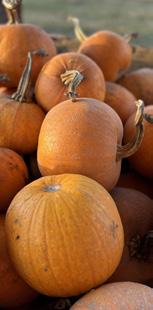
Find your passion, then devote yourself to it, advises Greg Nance, state representative for the 23rd District. In a time of divisiveness, it’s more important than ever to keep trying, said Nance, an islander who turns 37 in September.
Why did you go into public service?
BY CONNIE BYE
PHOTO BY ANNIE GRAEBNER
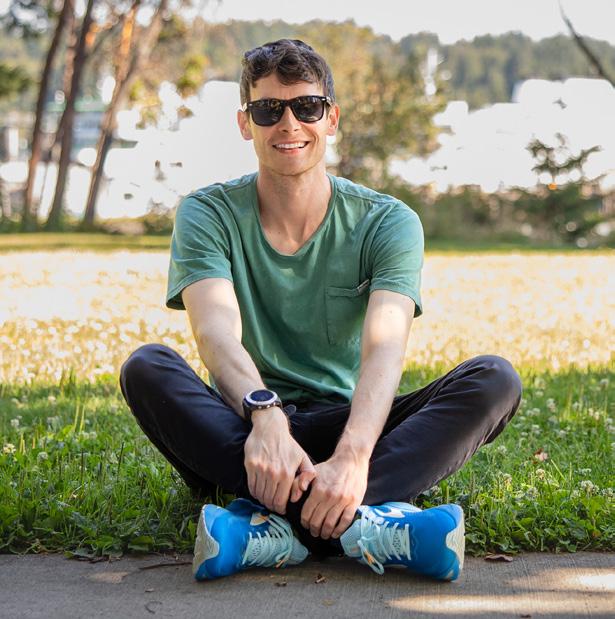
What is the answer on our ferry system?
We are turning a corner. Reliability is paramount. More boats on the water, more crews prepared, more maintenance and preservation. We fell $250 million behind on maintenance and preservation. We fell way behind on our staffing goals. Now, we have 2,100 crew members. We still need to get more vessels back in the water. We passed the Mosquito Fleet Act in the last session. We need to get this through the Senate and signed into law.
My dad helped unionize the Seattle Public Defenders office. My mom was a longtime nursing home social worker for the state. During family dinners, I heard about my parents making a difference. It planted a seed about using your talents, your intelligence to help others. And I love running, getting out there, meeting people. All those experiences led me to this moment.
When did you decide to seek office?
I had finished a run across America. There was a lot of time for thinking. One recurring idea was how few kids I met had good after-school activities. I had such an amazing support network: great coaches, great teachers, great mentors. Within a year and a half, there I was, running for office.
In a fragmented era, is it an extra challenge for you as a younger legislator?
Without a doubt, this is a difficult time in our history. Neighbor turned against neighbor. I am trying to be a bridge builder. Our system only works when we find ways to come back together.
You were a high school debate champ. Is that helpful in Olympia?
With debate, I realized quickly how valuable it is to learn to argue for an issue, then maybe an hour later to argue against it. That’s a powerful model for a democracy; you have to see both sides to make a good decision.
These would be private vessels?
Public vessels, perhaps privately paid for and utilized to answer needs. For example, Liberty Bay Poulsbo to downtown Seattle, Bremerton to Bainbridge. Also, an airport express from Eagle Harbor to Des Moines, then a 2-minute bus ride to SeaTac.
Why did you champion bull kelp?
Baby salmon swimming to the sea can rest in kelp, but we’ve lost 90 percent of the coverage. I was honored to work with Puget Sound Restoration Fund, our Suquamish and S’Klallam tribes. I’m surrounded by people who care.
What will be your focus in the year ahead?
I was just appointed liaison to Sound Partnership, an outstanding environmental organization. Bull kelp efforts. And making a big move for Dungeness crabs; it’s our biggest fishery. But we’ve had five major die-offs. Is the culprit ocean acidification, warming waters, European green crabs, algae blooms? We need to gather more facts and have the courage to push through.
Second, After School for All is going to be a big lift. We’ve got to design it so it’s inexpensive to start, and then we can bring more support. Ultimately, how do you build a pilot program?
Third, the transportation portfolio: fast ferries, safe streets, multimodal transportation. We need more sidewalks, bike lanes, safe avenues, no matter how you get around.


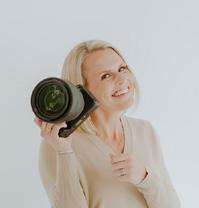




and private counseling space for children and adults.
BY CONNIE BYE PHOTOS COURTESY HELPLINE HOUSE
With an eye to growing needs, Helpline House is constructing a building that should serve its island clients for at least 50 years.
Demolition of the old building, at 282 Knechtel Way NE, began in the spring, and if all goes according to plan, the new facility will open at that same location in May 2026, said Maria Metzler, executive director of the nonprofit agency.
“It feels like a gift to our community,” Metzler said.
The old, familiar structure lasted nearly five decades, but as needs for assistance grew on Bainbridge Island, the available space became increasingly cramped, Metzler said. The old building was about 7,000 square feet, compared with 12,750 square feet in the new one, which will include a larger market area, community meeting spaces, more storage
Total visits to its food bank grew from 15,045 in 2022 to 18,580 in 2024. And with recent reductions in federally funded programs, such as the Supplemental Nutrition Assistance Program (SNAP), Metzler anticipates even more people with food insecurity will seek help and other assistance. Helpline estimates that 1 in 10 islanders use its various services each year.
Federal cutbacks have “upped the anxiety level about what is coming. People ask, ‘What does this mean for me?’” Metzler said. “We’ve seen more people talking with our social services staff.”

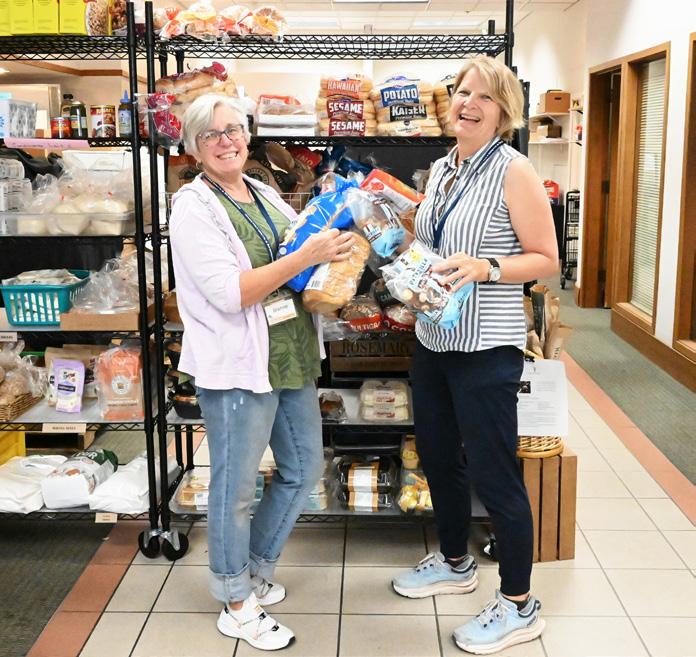

The Helpline board “did not expect to see that the uptick in demand for our services during the pandemic period would continue—and continue to grow so significantly,” board president Joan Hemphill said. “Seeing higher and higher numbers of clients coming through our doors every month is not what we were seeing 10 years ago, but it does seem to reflect where we are as a community today, due in part to an ever-increasing cost of living and other economic pressures.”
Metzler noted that “people may be working but need a little extra help sometimes.”
So far, financial support for the project has come from house parties, individuals and the Bainbridge Island Rotary Club, Town & Country Markets and Ace Hardware, Metzler said. Helpline also applied for and received a $2.5 million grant from the state of Washington

to support construction. It survived budget cutting in Olympia, Metzler said, and is the largest investment to date in the project.
The $12 million capital campaign includes the new building, the temporary move, additional large refrigeration and freezer equipment and other costs associated with the project, Metzler said. As the organization has closed in on the goal, the focus has shifted to fund-raising in the community. The organization set up a booth at the Grand Old Fourth of July celebration and plans to be on hand at the weekly Farmers Market to “let people know what we’re doing for their neighbors,” Metzler said.
Until the new facility opens, Helpline operates from temporary quarters at 901 Hildebrand Lane NE, a few blocks from the old facility. “We like to say we’re just around the corner,” Metzler said. Clark Construction owns the building and is leasing it to Helpline.
“It’s not perfect, but we couldn’t have asked for a more ready-to-use place to slot ourselves into,” Metzler said. For example, the building originally was a bank, and Helpline is using the old vault to store some goods.
Support for the new building is a way for Bainbridge residents to leave a lasting legacy, said Dean Lierle, development manager for the project. “There is a message in this about community and values that’s really important right now. It’s more than just building a building.”
For those who are feeling somewhat cynical about the human condition, Lierle advised focusing on good things, such as the difference Helpline makes on Bainbridge Island.
The community steps up for Helpline House, Lierle said. “We’re not popular with institutional funders. The assumption is that, oh, it’s Bainbridge Island, so they don’t need help. But the community understands who we are and wants to be sure their neighbors are taken care of.”
The old building was constructed in the early 1980s, “and over the years, the list of repairs for an aging building has continued to grow,” Hemphill noted. “And every year, every month, we are seeing higher numbers of people coming into the food bank and requesting assistance services.”
Helpline’s board weighed the costs of remodeling the old building versus creating a new facility, and found that new construction was the more cost-effective option, Hemphill said.

Jonathan Davis at Davis Studio Architecture + Design designed the new building. The work is being handled by Washington Patriot Construction, a veteran-owned company that also built a food bank in Gig Harbor, Metzler said.
“They are thorough, thoughtful,” she said. “They’ve made the process easy, even with a few bumps we’ve had.”
Rooftop solar panels should reduce ongoing energy expenses, Metzler noted. “Our goal was to be net neutral as much as possible.” Helpline hopes to achieve a LEED Silver designation, which is awarded by the U.S. Green Council. Additionally,
the facility will include an elevator to make it ADA compliant, she said.
Lierle, a social worker, said he was inspired after seeing the designs and offered to shepherd the fundraising efforts. “There’s incredible support for funding, but also time,” he said. Last year, volunteers donated 17,000 hours to Helpline, he noted.



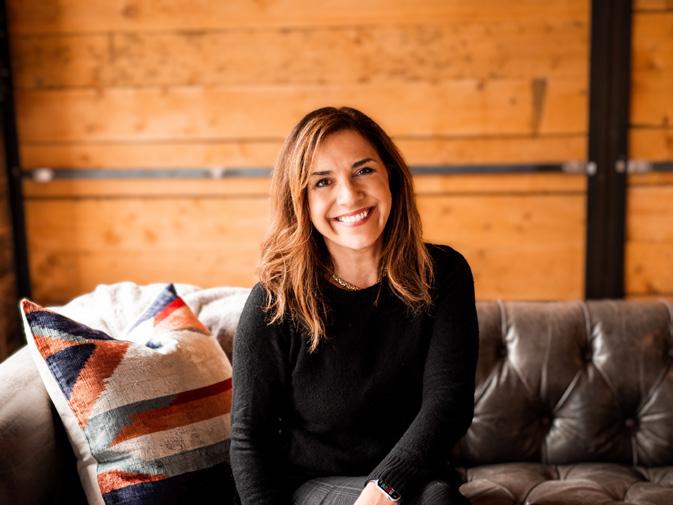





Helping you make every real e state decision with confidence - guided by local market expertis e, tailored s ervice and a re sults-driven approach


Each fall, Bainbridge is treated to the magical autumnal leaves of the island’s stunning Japanese maples.
BY AllI SCHUCHMAN
“They figure so prominently in both Japanese and Northwest gardening,” said arborist Ian Bentryn, widely recognized as an island tree authority. Bentryn maintains Bainbridge Public Library’s Haiku Garden, where he tends its celebrated lace leaf maples, in addition to working at many private homes on the island.
Bentryn explained that there are around half a dozen kinds of Japanese maples, but that within Acer palmatum, its most common species, there are at least 400 recognized varieties with a wide spectrum of colors, leaf patterns and growth habits. “You could say that for almost any garden situation, if you wanted a Japanese maple, there’s probably one that would fit what you need in that spot.”
One of Bentryn’s favorite trees on the island is a red Japanese maple near Hawley Cove. “It must be nearly a foot thick at the base,” he said. “A tree like that takes easily five hours a year just to do the maintenance pruning.”
Bentryn, who moved to the island in 1977 at age 10, feels fortunate to live in a place where people have such an interest in gardening and prioritize it so highly. “No one thinks you’re crazy if you put that much effort into your garden,” he said.









BY JEFF FRAGA
Stuffed breakfast waffles Are only the beginning.
The simple sandwich board appeared in front of the Cove in Winslow early one summer day.
What? Stuffed waffles? Yes—in both savory and sweet varieties, including:
• Bodega (bacon, egg, and cheese)

Each waffle starts with scratch-made batter, wrapped around fresh, seasonal fillings, then cooked to order in a specialized waffle press until golden and crisp on the outside. As the waffle cooks, the batter gently encases the filling, creating a hot, hand-held meal that’s both satisfying and portable—the perfect walking breakfast.
The stuffed waffles are the brainchild of Nik Ganea—who also owns the popular Sauce Nouvelle restaurant—and business partner Eric Matson. Their shared company is the Puget Sound Bagel Co. The pair recently relaunched its early morning service with the waffles, Montreal-style bagels, and baked goods. “It’s the first test site for a broader restaurant group we’re developing,” said Ganea.
• Fluffernutter (creamy peanut butter and marshmallow fluff)
• Sparta (blueberry and golden Meyer lemon filling named in honor of BHS)
• Count (a Monte Cristo with turkey, ham, and cheese, dusted with powdered sugar and raspberry glaze)
• Dark Matter, (black chocolate and Biscoff)
This was big news indeed—especially at 6:30 a.m., a time when Islanders looking for an early breakfast out usually are out of luck.
“We aim to incubate high-quality, small-footprint food businesses rooted in community values, then connect them with hyper-local sources,” added Matson.
“We very much intend to disrupt the current dependence on long-haul transportation of our food supply chain.”
Until then? Have another waffle!
Puget Sound Bagel Co., 278 Winslow Way E, Suite 109, 360-519-7997

¡Estos tacos son auténticos y muy deliciosos! Translation: Yum!
If you want authentic street tacos—like the ones they make in Mexico City—you have three choices: fly to Mexico City, take the 90-minute trip to Kent or visit Bainbridge Tacos. Just a few steps from







Walt’s is open 365 days a year. But the burgers are reserved for Fridays.
Every Friday, people from all over the island flock to Lynwood Center for a once-weekly event: hamburgers at Walt’s.



What started out as a way to generate revenue for Walt’s Market during the pandemic has become one of the most popular dining spots on Bainbridge Island. “I figured if we could sell 30 or 40 burgers every week, it would be worth our while,” said owner and Bainbridge Island native Walt Hannon. “We hit that mark and we’ve never looked back.”
Hannon estimated that he serves about 85 to 90 burgers each Friday from 11 a.m. to 1 p.m.
“We’ve probably never done fewer than 50 in the dead of winter,” he said. “It’s a nice change of pace

and I enjoy chatting with people while I work the grill.” If you’re doing the math, Hannon is flipping about three burgers every 4 minutes.
Hannon bought Walt’s in 1992, and the store has been at its current Lynwood Center location since 2003. “When we moved across the street to our current location, we must have had 50 people from the neighborhood help us move stuff,” Hannon said. “It was crazy.” That neighborhood spirit is a big part of what makes Walt’s Walt’s.
But back to the burgers. Hannon says they have proved to be so popular that Walt’s has added to the line-up. “Burger Friday has expanded to Prime Rib Dip Tuesday, Chicken Club Wednesday, and Taco Thursday,” said Hannon, adding that customers can also get ribs via special order.
Hannon summed up what the store is all about in 11 words: “We’re not a convenience store,” he said. “We’re your local market that’s convenient.”
Walt’s Lynwood Center Market, 4759 Lynwood Center Road NE, 206-842-5808


1. Pub Tunes
There’s no better time than fall for a cozy evening at the Harbour Public House, listening to lively folk tunes. In the spirit of an Irish pub, these musical gatherings are casual, loud and free of charge (provided you purchase pub fare). Plus, the Pub now welcomes clientele of all ages.
Third Wednesdays, Times TBA harbourpub.com
2. Dan Rosenberg’s Stand-Up Comedy Dojo
Side Quest Stage in Rolling Bay might be the place to finally pursue your dreams of stand-up comedy—or perhaps you’re just trying out stand-up because you lost a bet. Either way, local comedian Dan Rosenberg can help you workshop your jokes before you try them out on a larger audience.
Third Thursdays, 5 p.m. workshop, 7 p.m. showcase sidequeststage.com
3. Winney Farm Fall Festival
Celebrate the changing of the seasons with quintessential fall favorites: a pumpkin patch, hayrides and visits with farm animals. Winney Farm offers an idyllic backdrop for a variety of activities, plus plenty of food, drinks and live music to enjoy.
September 27, 11 a.m.–7 p.m. winneyfarm.com
4. Queer Bingo at the Senior Community Center

7. Refract Festival at BARN


As the tagline goes, Queer Bingo is “just like regular bingo, except a lot more queer.” Hosted by the Queer Elders Family Group, the event raises money for the Bill McKnight Legacy Scholarship, supporting local queer students studying arts and humanities.
October 25, 5 p.m. biseniorcenter.org

5. The Play that Goes Wrong at BPA
Fans of British humor (particularly of the slapstick variety) should get a kick out of this Olivier-Award-winning show about a theater troupe and their disastrous attempt at performing a murder mystery. Suitable for kids ages 10 and up.
October 3-26, Fridays and Saturdays 7:30 p.m., Sundays 3 p.m.
Bainbridgeperformingarts.com
6. Bainbridge Book Festival
The second annual Bainbridge Book Festival will include a keynote (on Friday), followed by a series of readings, Q&As and panel discussions from national, regional and local authors. Celebrating books of various topics and genres, the festival will have something for everyone.
October 10, 7 p.m. & October 11, 10 a.m. eagleharborbooks.com
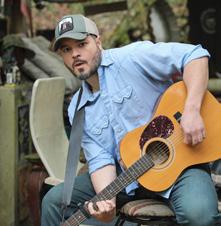
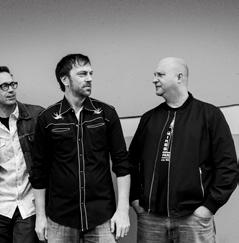
Seattle’s Refract festival draws glass artists and aficionados from around the Pacific Northwest to celebrate the region’s status as a hub for this reflective and whimsical medium. BARN will host an exhibit from October 17-19, and on October 19, visitors can watch a glass blowing demonstration and even make a piece of art themselves.
October 17-18, 10 a.m.–5 p.m., October 19, 10 a.m.–3 p.m. (for dates and times of events in Seattle, visit refractseattle.org) bainbridgebarn.org
8. Bainbridge Island Film Festival
While BI Film Fest includes independent films from around the world, the event is especially notable for its commitment to championing local work, including films shot on and around Bainbridge. With its catalog of impressive artistry and delightful variety, the festival is not to be missed.
November 6–9, Showtimes TBA bifilmfest.org
9. Staxx Brothers at the Treehouse Cafe
The Staxx Brothers manage to combine rock, country and soul into a high-energy musical medley that’s tough not to dance to. Or, in the words of frontman Davin Michael Stedman, they play “hard-ass soul.”
November 8, 7 p.m. treehousebainbridge.com
10.Poulsbo Kids Book Festival
This celebration of reading is aimed at area children and their families. About 40 authors and illustrators will be on hand to sign autographs and chat at the North Kitsap High School Commons. Last year, the fest drew 1,400 people. Free admission.
November 15, 11 a.m-3 p.m. poulsbokidsbookfest.com
11. Massy Ferguson at the Treehouse Cafe
Crowd favorite and alt-country staple of the PNW Massy Ferguson will be back at the Treehouse with lively tunes. After 20 years of serving up a rock-country blend perfect for a night of dancing at the bar, the band released its seventh album this year, experimenting with a slightly different sound.
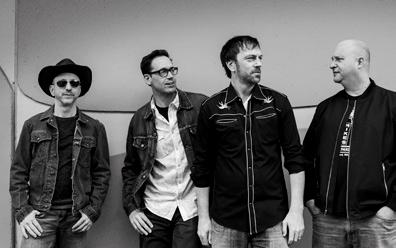
November 15, 7 p.m. treehousebainbridge.com
The median age of owner-occupied homes in the U.S. is now over 40 years, reflecting an aging housing stock that increasingly needs updates and repairs. As a result, the home remodeling market is experiencing steady growth, driven by homeowners investing in updating kitchens, bathrooms, as well as aging in place improvements. This trend signals strong demand for skilled contractors and renovation services.
Contact Cogwheel Construction regarding your remodeling plans for a free detailed estimate. We stand by our slogan ‘Built on Trust. Crafted with Care.’ Utilizing open book transparency with a cost plus model, enabling us to work with homeowners to meet and exceed budget goals, and finish quality expectations.
For small projects, routine maintenance work, and repairs contact Toolbox Dispatch for a free estimate. We work hard to complete small projects in a 1-2 week window and larger projects with material orders scheduled for completion within 4-6 weeks subject to material lead times. Toolbox utillizes the same transparent cost plus structure.



Islander Terry Birch frequently shares photos on Facebook of the wildlife who find his yard, near Fletcher Bay simply irresistible. He luckily snapped this black bear last July. “He’s been visiting once or twice a year for several years now and I suppose he remembers the location because of the bird feeders,” said Birch. “We just happened to see him before he ran off!”
BY ALLI SCHUCHMAN
Fieldstone Rolling Bay offers independent living, assisted living, and memory care—all on one thoughtfully designed campus nestled in the scenic hills of Bainbridge Island. Residents enjoy chef-prepared meals at Gerald’s Restaurant, panoramic views from the Sky Lounge, and amenities like a putting green, art studio, salon, and theater. Whether relaxing in beautifully appointed apartments or joining friends for gardening, fitness classes, or creative workshops, life at Fieldstone is all about connection, comfort, and the freedom to live well every day.

After retiring from 25 years of teaching in Riverside, California, Connie Everett followed her heart to Bainbridge Island—a place she fell in love with while visiting her brother. Drawn to the island’s natural beauty and strong sense of community, she sought a life of peace, creativity, and connection.

When her Parkinson’s symptoms began to worsen, Connie made the move to Fieldstone Rolling Bay. “I needed a safe space with a sense of freedom—somewhere I could truly be myself,” she shares.
Since arriving in April, her health has improved significantly. “My blood pressure and stress have gone way down. I finally have time to do the things I love. Keeping my mind busy helps with the Parkinson’s.” Surrounded by her artwork and constant companion, Bao Bao, Connie spends her days quilting, drawing, and preparing for the Bainbridge Island Quilt Show. She also creates quilts for Memory Care residents and speaks at the community’s Dementia Support Group. Connie lives by the mantra: “There are no straight lines.” At Fieldstone, she’s found a place that embraces that philosophy—where life, in all its beautiful imperfection, continues to unfold with purpose and joy.


Now is the ideal time to plan your move to Heron’s Key, a vibrant Life Plan Community in nearby Gig Harbor. With new apartment and cottage homes ranging from 1000 sq ft to 2500 sq ft, opening in 2028, you’ll enjoy priority access, more floor plan options, and the same engaging lifestyle our residents already love.
As a Type A Life Plan Community, Heron’s Key o ers predictable monthly costs—even if your healthcare needs change. And as a not-for-profit, we reinvest in what matters most: our residents’ wellbeing and community experience. Plan ahead. Live fully. Schedule Your Visit Today. www.heronskey.org/expansion 253-525-5204





